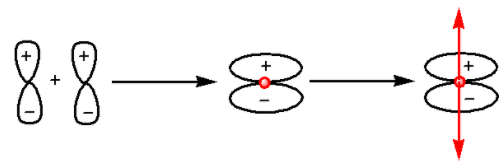
Which is the correct statement about ${{\sigma }}$- and ${{\pi }}$-molecular orbitals? Statements are
(i) ${{\pi }}$-bonding orbitals are ungerade
(ii) ${{\pi }}$-antibonding orbitals are ungerade
(iii) ${{\sigma }}$-antibonding orbitals are gerade
(A) (i) only
(B) (ii) and (iii) only
(C) (iii) only
(D) (ii) only
Answer
463.5k+ views
Hint: To solve this we will consider the molecular orbital theory (MOT). MOT describes structure and properties of different molecules. MOT explains about the single bond and double bond in the resonating structure of molecules.
Complete Step by step answer: We can determine the symmetry of a molecule by rotating the molecule through the center of symmetry.
If we invert a molecule through the center of symmetry and the sign of the molecular orbital does not change then the molecular orbital is said to be gerade. It is denoted by g.
If we invert a molecule through the center of symmetry and the sign of the molecular orbital changes then the molecular orbital is said to be ungerade. It is denoted by u.
We know that the ${{\pi }}$-bonding orbitals are formed by the constructive interference of two electron waves of atomic orbitals. The formation of ${{\pi }}$-bonding orbitals is as follows:

In the given diagram, above the point there is a positive wave function and below the point there is a negative wave function. Thus, there is no center of symmetry. Thus, ${{\pi }}$-bonding orbitals are ungerade.
We know that the ${{\pi }}$-antibonding orbitals are formed by the destructive interference of two electron waves of atomic orbitals. The formation of ${{\pi }}$- antibonding orbitals is as follows:

In the given diagram, there is a center of symmetry. Thus, ${{\pi }}$-antibonding orbitals are gerade.
We know that the ${{\sigma }}$-antibonding orbitals are formed by the destructive interference of head on overlapping atomic orbitals. The formation of ${{\sigma }}$-antibonding orbitals is as follows:

In the given diagram, there is no center of symmetry. Thus, ${{\sigma }}$-antibonding orbitals are ungerade.
Thus, the statement ‘${{\pi }}$-bonding orbitals are ungerade’ is correct.
Thus, the correct option is (A) (i) only.
Note: We know that the molecule has covalent bonds there are sigma bonds and pi bonds. The sigma bonds are represented by ${{\sigma }}$ and the pi bonds are represented by ${{\pi }}$. The bond formed between two atoms by the axial overlap of the atomic orbitals along the intermolecular axis is known as the sigma bond.
The bond formed by the lateral overlap of the atomic orbitals at right angles to the intermolecular axis is known as the pi bond.
Complete Step by step answer: We can determine the symmetry of a molecule by rotating the molecule through the center of symmetry.
If we invert a molecule through the center of symmetry and the sign of the molecular orbital does not change then the molecular orbital is said to be gerade. It is denoted by g.
If we invert a molecule through the center of symmetry and the sign of the molecular orbital changes then the molecular orbital is said to be ungerade. It is denoted by u.
We know that the ${{\pi }}$-bonding orbitals are formed by the constructive interference of two electron waves of atomic orbitals. The formation of ${{\pi }}$-bonding orbitals is as follows:

In the given diagram, above the point there is a positive wave function and below the point there is a negative wave function. Thus, there is no center of symmetry. Thus, ${{\pi }}$-bonding orbitals are ungerade.
We know that the ${{\pi }}$-antibonding orbitals are formed by the destructive interference of two electron waves of atomic orbitals. The formation of ${{\pi }}$- antibonding orbitals is as follows:

In the given diagram, there is a center of symmetry. Thus, ${{\pi }}$-antibonding orbitals are gerade.
We know that the ${{\sigma }}$-antibonding orbitals are formed by the destructive interference of head on overlapping atomic orbitals. The formation of ${{\sigma }}$-antibonding orbitals is as follows:

In the given diagram, there is no center of symmetry. Thus, ${{\sigma }}$-antibonding orbitals are ungerade.
Thus, the statement ‘${{\pi }}$-bonding orbitals are ungerade’ is correct.
Thus, the correct option is (A) (i) only.
Note: We know that the molecule has covalent bonds there are sigma bonds and pi bonds. The sigma bonds are represented by ${{\sigma }}$ and the pi bonds are represented by ${{\pi }}$. The bond formed between two atoms by the axial overlap of the atomic orbitals along the intermolecular axis is known as the sigma bond.
The bond formed by the lateral overlap of the atomic orbitals at right angles to the intermolecular axis is known as the pi bond.
Recently Updated Pages
Master Class 11 Accountancy: Engaging Questions & Answers for Success

Glucose when reduced with HI and red Phosphorus gives class 11 chemistry CBSE

The highest possible oxidation states of Uranium and class 11 chemistry CBSE

Find the value of x if the mode of the following data class 11 maths CBSE

Which of the following can be used in the Friedel Crafts class 11 chemistry CBSE

A sphere of mass 40 kg is attracted by a second sphere class 11 physics CBSE

Trending doubts
Define least count of vernier callipers How do you class 11 physics CBSE

The combining capacity of an element is known as i class 11 chemistry CBSE

Proton was discovered by A Thomson B Rutherford C Chadwick class 11 chemistry CBSE

Find the image of the point 38 about the line x+3y class 11 maths CBSE

Can anyone list 10 advantages and disadvantages of friction

Distinguish between Mitosis and Meiosis class 11 biology CBSE




